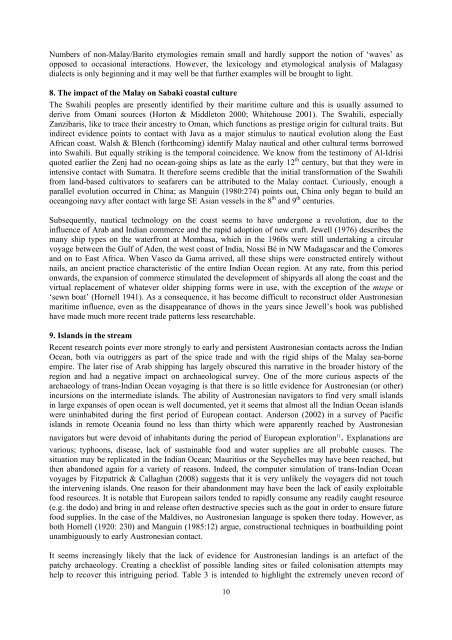Paper for Cambridge 2007 proceedings submit.pdf - Roger Blench
Paper for Cambridge 2007 proceedings submit.pdf - Roger Blench
Paper for Cambridge 2007 proceedings submit.pdf - Roger Blench
You also want an ePaper? Increase the reach of your titles
YUMPU automatically turns print PDFs into web optimized ePapers that Google loves.
Numbers of non-Malay/Barito etymologies remain small and hardly support the notion of ‘waves’ as<br />
opposed to occasional interactions. However, the lexicology and etymological analysis of Malagasy<br />
dialects is only beginning and it may well be that further examples will be brought to light.<br />
8. The impact of the Malay on Sabaki coastal culture<br />
The Swahili peoples are presently identified by their maritime culture and this is usually assumed to<br />
derive from Omani sources (Horton & Middleton 2000; Whitehouse 2001). The Swahili, especially<br />
Zanzibaris, like to trace their ancestry to Oman, which functions as prestige origin <strong>for</strong> cultural traits. But<br />
indirect evidence points to contact with Java as a major stimulus to nautical evolution along the East<br />
African coast. Walsh & <strong>Blench</strong> (<strong>for</strong>thcoming) identify Malay nautical and other cultural terms borrowed<br />
into Swahili. But equally striking is the temporal coincidence. We know from the testimony of Al-Idrisi<br />
quoted earlier the Zenj had no ocean-going ships as late as the early 12 th century, but that they were in<br />
intensive contact with Sumatra. It there<strong>for</strong>e seems credible that the initial trans<strong>for</strong>mation of the Swahili<br />
from land-based cultivators to seafarers can be attributed to the Malay contact. Curiously, enough a<br />
parallel evolution occurred in China; as Manguin (1980:274) points out, China only began to build an<br />
oceangoing navy after contact with large SE Asian vessels in the 8 th and 9 th centuries.<br />
Subsequently, nautical technology on the coast seems to have undergone a revolution, due to the<br />
influence of Arab and Indian commerce and the rapid adoption of new craft. Jewell (1976) describes the<br />
many ship types on the waterfront at Mombasa, which in the 1960s were still undertaking a circular<br />
voyage between the Gulf of Aden, the west coast of India, Nossi Bé in NW Madagascar and the Comores<br />
and on to East Africa. When Vasco da Gama arrived, all these ships were constructed entirely without<br />
nails, an ancient practice characteristic of the entire Indian Ocean region. At any rate, from this period<br />
onwards, the expansion of commerce stimulated the development of shipyards all along the coast and the<br />
virtual replacement of whatever older shipping <strong>for</strong>ms were in use, with the exception of the mtepe or<br />
‘sewn boat’ (Hornell 1941). As a consequence, it has become difficult to reconstruct older Austronesian<br />
maritime influence, even as the disappearance of dhows in the years since Jewell’s book was published<br />
have made much more recent trade patterns less researchable.<br />
9. Islands in the stream<br />
Recent research points ever more strongly to early and persistent Austronesian contacts across the Indian<br />
Ocean, both via outriggers as part of the spice trade and with the rigid ships of the Malay sea-borne<br />
empire. The later rise of Arab shipping has largely obscured this narrative in the broader history of the<br />
region and had a negative impact on archaeological survey. One of the more curious aspects of the<br />
archaeology of trans-Indian Ocean voyaging is that there is so little evidence <strong>for</strong> Austronesian (or other)<br />
incursions on the intermediate islands. The ability of Austronesian navigators to find very small islands<br />
in large expanses of open ocean is well documented, yet it seems that almost all the Indian Ocean islands<br />
were uninhabited during the first period of European contact. Anderson (2002) in a survey of Pacific<br />
islands in remote Oceania found no less than thirty which were apparently reached by Austronesian<br />
.<br />
navigators but were devoid of inhabitants during the period of European exploration 11 Explanations are<br />
various; typhoons, disease, lack of sustainable food and water supplies are all probable causes. The<br />
situation may be replicated in the Indian Ocean; Mauritius or the Seychelles may have been reached, but<br />
then abandoned again <strong>for</strong> a variety of reasons. Indeed, the computer simulation of trans-Indian Ocean<br />
voyages by Fitzpatrick & Callaghan (2008) suggests that it is very unlikely the voyagers did not touch<br />
the intervening islands. One reason <strong>for</strong> their abandonment may have been the lack of easily exploitable<br />
food resources. It is notable that European sailors tended to rapidly consume any readily caught resource<br />
(e.g. the dodo) and bring in and release often destructive species such as the goat in order to ensure future<br />
food supplies. In the case of the Maldives, no Austronesian language is spoken there today. However, as<br />
both Hornell (1920: 230) and Manguin (1985:12) argue, constructional techniques in boatbuilding point<br />
unambiguously to early Austronesian contact.<br />
It seems increasingly likely that the lack of evidence <strong>for</strong> Austronesian landings is an artefact of the<br />
patchy archaeology. Creating a checklist of possible landing sites or failed colonisation attempts may<br />
help to recover this intriguing period. Table 3 is intended to highlight the extremely uneven record of<br />
10

















